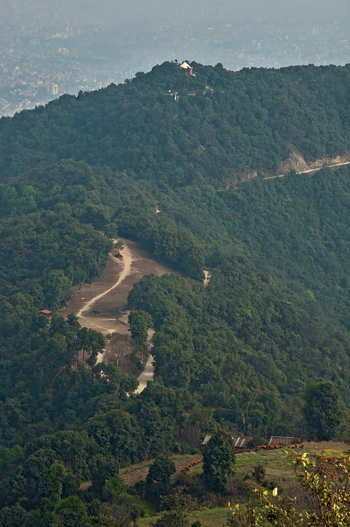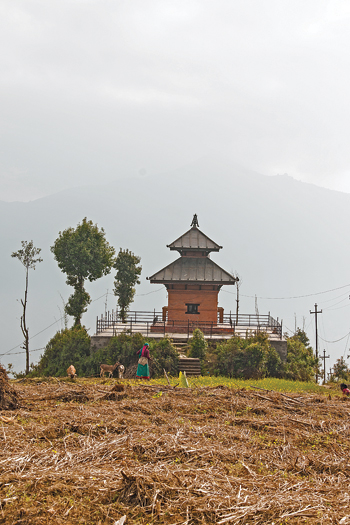 A history junkie’s visit to Daha Chowk, a place where Prithvi Narayan Shah had set up a base camp before marching east into Kathmandu Valley.
A history junkie’s visit to Daha Chowk, a place where Prithvi Narayan Shah had set up a base camp before marching east into Kathmandu Valley.
On this quiet morning from this foggy vantage point, it is hard imagine that this sleepy settlement is perched on such intriguing history. A short ride west of Kathmandu, past the speeding trucks of Thankot, we veer right, through Naikap and Balambu onto a dusty road that climbs upwards towards Daha Chowk. Here I am told, a young Prithivi Narayan Shah set up his base camp before marching east into Kathmandu Valley and immortalizing folklore. The history junkie in me is itching with rabid anticipation. So much fell through the gaps of our monotonous Social Studies books.
As we climb upwards, the vista opens up. The road is lined on either side with thick rhododendron trees, and beyond it the valley sleeps in the morning fog. This land that once used to be rich farm country is now teeming with gangly concrete structures that stretch out as far as the eye can see. Something about it is terribly repugnant, and Chandragiri that rises ominously in front of us, looks away in silent disapproval.
We stop at a set of stairs that leads up to a plateau from where a small temple juts out into the sky. There we find a few workers plastering the dome roof in no particular hurry. To find this beautiful hexagonal temple in the middle of this thick unsuspecting forest takes me by surprise. Dedicated to Goddess Binda Basini, I learn that the sculpture had been carved out of a single rock extracted out the Kankai River in Jhapa, by the sculptor Manjul. He had been commissioned to fashion the sculpture after a statue in Gorakhpur, India, but since photography isn’t allowed at the temple, the sculptor, carved the goddess based on the descriptions of the Head Priest there. In my head, I imagine him speculating the features of the Durga, like a police officer trying to draw the features of a wanted run-away and smile to myself.

There are no signboards here, no epitaphs. If it wasn’t for my friend who is doubling up as an enthusiastic guide, all these details would be lost to my eyes. Why then, an elaborate temple in the middle of nowhere, I ask. For centuries, apparently, locals had been worshiping a tree stub where now the temple stood, as a sacred space for Baan Kaali. But upon investigation, it was uncovered that it was in fact the spot where Prithivi Narayan Shah, made his final offerings before marching into Kirtipur, which idles in the distance. The entire base of the plateau is circumvented by a narrow trench and it becomes clear to me that I am standing on a site of tremendous historical importance.
 Further up the road, the forest opens up into a lush
Further up the road, the forest opens up into a lush
clearing. Here a few scant tin sheds stand ignored and unoccupied. Again to an unsuspecting eye, this prairie looks like the many picnic destinations around the valley, which on a holiday would be packed by denizens drinking and dancing to lewd Bollywood tunes. The scattered piles of rubbish stand witness. My friend tells me that here, the young Gorkha king conducted parades and military exercises, before his march east. Here many a Khukuri and Muskets must have glistened under the thick cover of the forests, while the valley below ambled on unaware. The weight of history descends on me. These hills are teeming with stories waiting to be told. Only the bards are nowhere to be seen.
We ride on upwards and arrive at Indresthan, a quaint settlement of terraced corn fields overlooked by a small army barrack. I notice the barrack is guarding a conspicuously small communication tower. This is where, I am told, the ill-fated 1999 Necon Air flight crashed killing all 15 people onboard. Arriving from Pokhara the Flight 128 crashed into the Nepal Telecommunication Authority’s tower here, before falling into the thick forests below. The stub of the tower stands as a grizzly monument to all that that has come to pass.
Further up the road at in a stately tomb lies the fabled Kaji Kalu Pandey. A tiered crypt of jagged black stone stands here looking over the western hills. Legends speak of the general’s wish to be buried here with his gaze pointed towards Gorkha, his home, and the Manakamana Temple, the headwaters of his devotion. Here we find the first epitaph we’ve found all day. Erected by the Kaji Kalu Pandey Kaji Tularam Pandey Smriti Prathisthan, in golden script etched on polished black stone, it speaks of the finer points of his short life and of his wish to be buried here at the said spot. Kaji Kalu Pandey, died in the first of three waves of attacks that the Gorkhali soldiers launched on the citadel of Kirtipur. The General tried time and again to dissuade his King from launching the attack, asking him to bide his time. But the young king remained resolute. Centuries later, in jarring retrospect, I wonder if the Kaji knew that he was marching to his death. An honorable man walking the proverbial plank.
A little ways ahead, an exact replica of the Manakamana Temple is being renovated. A temple was originally established here by the Gorkhali soldiers in May of 1757. Here they worshiped an idol of Bhagvati, praying for strength and good fortune. It was bequeathed to them in abundance. Today, the temple stands proud in the morning fog. Kaji Kalu Pandey, who never got to see a unified Nepal, at least had his last wish honored. In rain, in shivering cold, and even in the sweltering summer haze, his eyes are forever fixed on his beloved Manakamana.
It is here that I am reminded that we live in a living museum. From the decaying decrepit gallis of the valley to these hills filled with legends and folklore, we walk on history every day. Even though there are no proud banners or glorified guides with broken English to edify it to us, lying just under the surface waiting to be unearthed is a vast world of intrigue and enigma. My head swarms with visions of thousands of school children, from the thousands of schools of the valley below, swarming these hills to learn the history that we walk upon. This foggy hillside should be cackling with excited chatter, bustling with activity; but only we carve two lonely silhouettes here today.
The weight of history descends on me. There are no bards here.
Today, all is quiet on the western front.









